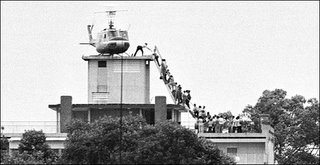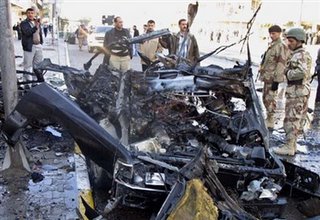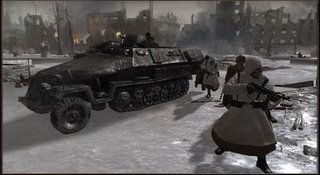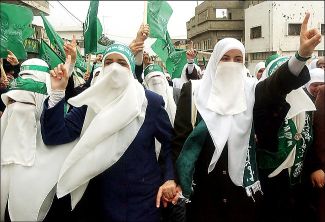
Former Nixon Defense Secretary Melvin Laird has gotten some attention with his recent
Foreign Affairs article recommending a repeat of Vietnamization in Iraq. Essentially Laird endorses Bush's "Iraqis stand up, Americans stand down" course in Iraq, with the focus on training Iraqi security forces to take the place of American forces. Laird considers the American Army's exit from South Vietnam in 1972 as a model to be followed to achieve decisive success in Iraq, which might seem odd given that South Vietnam doesn't exist any longer. Not to Laird, however:
The truth about Vietnam that revisionist historians conveniently forget is that the United States had not lost when we withdrew in 1973. In fact, we grabbed defeat from the jaws of victory two years later when Congress cut off the funding for South Vietnam that had allowed it to continue to fight on its own.
...
Documents released from North Vietnamese historical files in recent years have proved that the Soviets violated the treaty from the moment the ink was dry, continuing to send more than $1 billion a year to Hanoi. The United States barely stuck to the allowed amount of military aid for two years, and that was a mere fraction of the Soviet contribution.
Yet during those two years, South Vietnam held its own courageously and respectably against a better-bankrolled enemy. Peace talks continued between the North and the South until the day in 1975 when Congress cut off U.S. funding. The Communists walked out of the talks and never returned. Without U.S. funding, South Vietnam was quickly overrun.
...
I believed then and still believe today that given enough outside resources, South Vietnam was capable of defending itself, just as I believe Iraq can do the same now. From the Tet offensive in 1968 up to the fall of Saigon in 1975, South Vietnam never lost a major battle. The Tet offensive itself was a victory for South Vietnam and devastated the North Vietnamese army, which lost 289,000 men in 1968 alone.
Apparently some folks in the blogosphere think that the man who was responsible for implementing a program is the most objective observer regarding its success. Unfortunately, Laird is engaged in some rather egregious revisionism of his own here.
U.S. funding of South Vietnam, first of all, continued at a high rate through 1975. From 1973-74, the U.S. provided South Vietnam with $3.3 billion in aid --- three times the amount of Soviet aid listed by Laird. In 1975, this was cut not to nothing, but to $700 million. Lewis Sorley and other revisionist historians like to talk about ARVN troops running out of ammunition, but this was largely due to massive and endemic corruption throughout the South Vietnamese high command, not lack of American aid. And as Melvin L. Pribbenow relates in Parameters, the North Vietnamese too had ammunition supply problems that were a major factor in their strategic planning for 1975.
By 1974, PAVN's entire stock of heavy artillery and tank ammunition, including all ammunition held by combat units at forward warehouses, and in North Vietnam's strategic reserves, totaled just 100,000 rounds. The ammunition problem was so serious that the PAVN artillery command had to replace the larger weapons in a number of units with obsolete 76.2mm and 57mm artillery pieces drawn out of storage for which there still was adequate ammunition.
Indeed, Pribbenow goes on to relate that much of the artillery fired in support of the North's offensive in 1975 was captured from overrun ARVN units, which were lavishly stocked in comparison.
During their initial attacks Tra's troops overran the small ARVN outposts at Bu Dang and Bu Na on Route 14. COSVN Military Command reported to Hanoi on 20 December that within the ruins of these two outposts PAVN forces had captured intact four 105mm howitzers and 7,000 rounds of artillery ammunition. This unexpected treasure trove stunned the leadership in Hanoi. Seven thousand rounds were more than half the number the General Staff had planned to expend nationwide during the entire 1975 campaign. Tra now argued that he could use this bonanza for his planned attack on the Phuoc Long province capital without even touching his current ammunition holdings. In fact, PAVN could expect to capture even more ammunition at the larger bases. It was an argument the leadership could not resist. Tra was authorized to proceed with his original plans. On 6 January the PAVN 3d and 7th Divisions completed the conquest of Phuoc Long province by taking the province capital and capturing another 10,000 rounds of artillery ammunition.
Laird also skedaddles over much of the ARVN's history. The ARVN suffered several major defeats post-1968. Operation Lam Son 1971, the South Vietnamese invasion of Laos, ended with ARVN airborne LZs overrun and panicked troops
pushing their own wounded off evac helicopters to escape. The 1972 Easter Offensive, generally regarded in the U.S. as a crushing defeat for the North Vietnamese, would likely have destroyed South Vietnam without the presence of American advisors, who provided most of the combat leadership in the
most crucial battles, and even more importantly massive and overwhelming B-52 "Arclight" strikes on NVA troop concentrations. Even given the massive losses incurred on the North Vietnamese and their failure to hold any population center, they still took control of most of the Central Highlands region. As Eric Bergerud
notes:
Dubbed the 'Third Vietnam" by journalists, the huge expanses of mountain and jungles controlled by the Party's forces served as the ultimate liberated zone. Thieu continued to garrison the area's cities, putting a sizable portion of the ARVN in an untenable postion once PAVN was resupplied. Hue was likewise nearly under siege. All this had been gained by Hanoi despite a withering U.S. air and artillery offensive and brilliant tactical leadership by the American military advisors who, in fact, commanded ARVN ...
Starting with the 1973-74 dry season, Hanoi did not miss a step. Most of the PAVN continued to reequip, and much effort was spent creating a series of all-weather roads down the Ho Chi Minh Trail and deep into South Vietnam ... PAVN and what was left of Front forces struck hard in a series of 'strategic raids' around Saigon, Hue, and Danang. Many GVN outposts were overrun, and old strategic safe zones near Saigon lost after Tet 1968 were reclaimed by the Party's forces. In the Mekong Delta ... the Front launched a furious assault on the pacification program and, in many areas, destroyed four years of 'progress' in a few weeks ...
When the North Vietnamese went on the offensive in 1975, the ARVN collapsed. Generals abandoned their troops; soldiers fled their posts. Fifty-five days later, South Vietnam had ceased to exist.
Does any of this sound like success to you?
By the way, training for our new Iraqi Army was recently boosted --- to 24 days (hat tip Daily Kos). Most soldiers in the Iraqi Army have 14 days of training, which is slightly more than security guards in New York state are required to get. I wonder how long ARVN basic training lasted.





